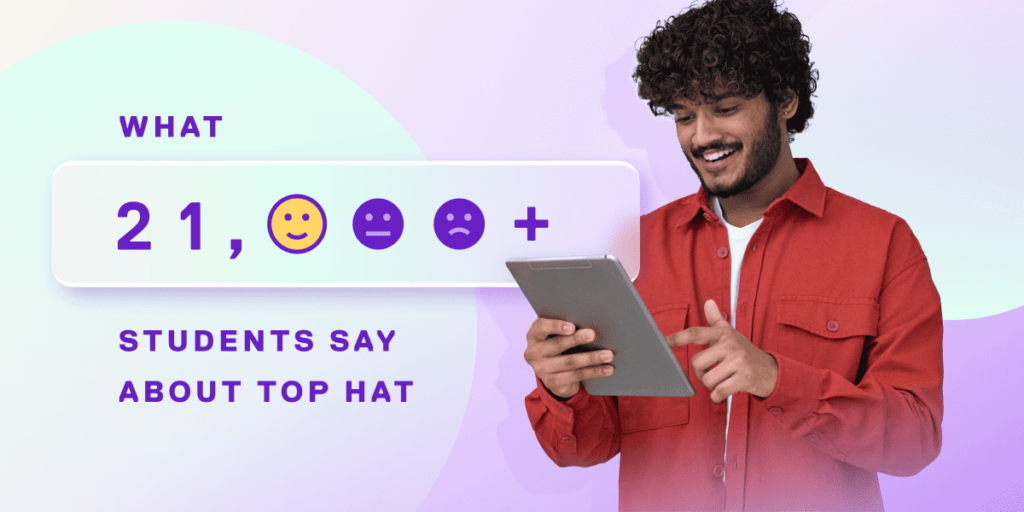In an online learning environment, one of the most important steps educators can take—and one that can alleviate some anxiety and frustration—is determining what content should be delivered to students synchronously (live or in real-time) and what learning can be supported asynchronously (recorded or self-paced). And while the reality is that effective online teaching requires a combination of both methods, ultimately, the key is to play to the strengths of each approach.
Making synchronous lectures engaging
In the online world, teaching synchronously most closely mirrors the physical classroom experience. Delivering course content and presentations ‘live’ creates a sense of immediacy and intimacy that is particularly effective for student engagement. Participating in discussions and working through course concepts together in real-time are two essential elements of synchronous learning, giving students opportunities to apply learning and collaborate with peers. Synchronous presentations are especially useful when course material is complex and may require feedback or clarification in the moment to keep students on track.
As a general rule, lecturing for 50 or 75 minutes is not the ideal way to engage students at the best of times, less so in a virtual environment. For this reason, it’s important to consider how to use your precious class time most effectively. In the spirit of active learning, ‘flipping’ your classroom may make sense. This worked for Daniel Maxwell, a criminal justice lecturer at the University of New Haven. Instead of using slides or presenting new content during online class meetings, he assigns interactive textbook readings prior to class with pertinent details highlighted in red to give his students focus. He then facilitates a discussion in class based on student responses to pre-class textbook assignments.
This can help make the learning process more engaging for students. There are important social benefits as well. The opportunity to connect with peers and collaborate on problem-solving exercises can go a long way in alleviating the sense of isolation that can exist in online environments.
How synchronous teaching supports active learning
To ensure students are actively engaged, it’s important to balance content delivery with interactivity and time for reflection. Similar to a face-to-face classroom environment, it’s recommended that the time to present information is kept to 10 to 15-minute blocks followed by more interactive components. Discussions, class polls, ‘click on target’ questions using an ed-tech platform and giving students time to reflect on their learning through ‘minute papers’ are simple ways to drive engagement and reinforce important concepts. Regular use of these activities can also help you pinpoint where students are struggling and which concepts need revisiting.
How to drive student engagement synchronously
- Peer connections are crucial in creating a sense of belonging and motivating students to participate in the course. Using icebreakers, polling questions and other fun activities are great ways to foster connections between peers.
- Frequent feedback helps students succeed by giving them the support and direction to re-focus their studies. Regular low-stakes assessments or quizzes are an important part of the process. They help create a consistent rhythm for students while providing instructors with a steady stream of insights into student progress.
- Using multimedia content like photos, videos, memes and real-world examples can help reinforce course concepts while adding variety to presentations. Instructors should make a habit of breaking up large blocks of text with multimedia elements to keep students engaged.
- Presence is integral to student engagement. It’s important to let learners know when you’re available to meet and provide them with the necessary resources to support them academically. Hosting regular virtual office hours and participating in online discussion threads are easy ways to reinforce a sense of caring and commitment.

Making asynchronous lectures engaging
Asynchronous learning is an integral part of active learning and is particularly useful if students are unable to maintain a specific schedule. Accessing materials, readings, assignments, quizzes and lecture recordings in a single place—which is possible on an active learning platform like Top Hat—allows students to explore topics in-depth and at their own pace. Supported by discussion forums and one-to-one communications through email are simple ways to create engagement even if much of the learning is self-directed.
Asynchronous learning also provides an opportunity for instructors to promote peer collaboration. Specific assignments that require students to work with each other or review each other’s work are powerful ways to keep engagement high outside the confines of a class schedule.
How asynchronous teaching supports active learning
In thinking through how best to incorporate asynchronous methods into your curriculum, take time to review your course syllabus and learning objectives for the semester. Do you have the ability to teach using both synchronous and asynchronous methods? If so, are there components that can be recorded for students to view on their own schedule? What is essential for synchronous delivery? How will students access readings and assignments? Thinking through these elements can help shape an effective plan and identify pedagogical as well as technical gaps you may need to address.
Frank Spors, an Associate Professor of Optometry at Western University of Health Sciences, expertly employs short, asynchronous assignments in Top Hat that students are required to complete before his live remote classes. These well-structured assessments start with an outline of the intended learning objectives, complemented by embedded YouTube videos of Spors reviewing course material. Assessment and discussion questions follow, which focus on identifying the content areas that require more clarification. He uses the feedback from these assignments to understand how well his students are comprehending the material they’ve learned to date, as well as the content they’ve been asked to tackle asynchronously. From here, he adjusts his lecture and takes time to respond directly to student questions using Top Hat or ‘in class’ over video. “I look at students’ responses literally minutes before the lecture to gauge their level of understanding,” Spors says. “Depending on how well concepts are understood, I either slow down, continue as planned, or accelerate my lecture materials.”
How to drive student engagement asynchronously
Active learning is not an isolated activity. In fact, you can incorporate active learning practices across every part of your curriculum and if you are employing both synchronous and asynchronous methods, this can be done before, during and after class. Here are some examples of activities that can be used at different stages of the learning journey:
- Before class – Short Quiz: Have students complete a short quiz on concepts discussed during the previous lecture. Regular, low-stakes assessments improve knowledge retention while giving instructors a mechanism to gauge how well students are grasping key concepts. If necessary, review the results before diving into the next topic, or spend more time on concepts that posed the greatest challenge for students.
- During class – Discussion Threads: Have students exchange drafts of their work and then come up with questions and comments for each other. Be clear about what the goals of the exercise are. For example, do you want to test a student’s understanding of a topic? Or perhaps how well they are able to apply something they learned to a real-life situation? You can also use discussion threads to explore more sensitive or polarizing topics by having students respond anonymously—a great way to engage, whatever the material.
- After class – Interactive Readings: With digital textbooks and course materials, you can incorporate active learning principles into simple reading assignments. This includes breaking up text with video and other multimedia elements and embedding questions to test for comprehension before students move onto subsequent sections. Online active learning platforms like Top Hat can automatically tabulate these results allowing you to shape your next lecture to address student needs.
A combination of synchronous and asynchronous methods will help keep your students engaged. Top Hat’s new virtual classroom capabilities can help re-create the best in-class experience—with high quality textbook materials, assignments and lectures—empowering students wherever learning takes place. Learn how you can take your online teaching to the next level while driving student success in our free guide.


